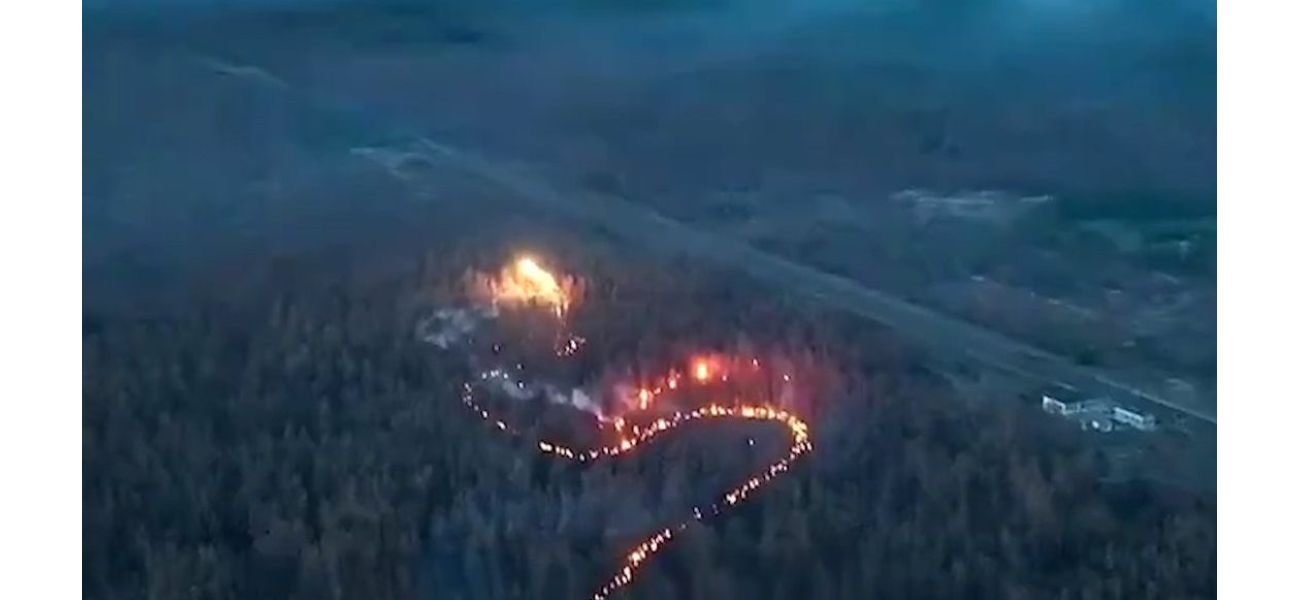Ukraine's 'Dragon' drones use fire as a psychological weapon, taking warfare to a whole new level.
Sudden sky firestorm: an unimaginable sight.
September 11th 2024.

In the ongoing conflict between Ukraine and Russia, a new weapon has emerged - the 'Dragon' drone. These drones have been seen in action, spewing fire and causing chaos in Russian positions. The footage from the 42nd Mechanised Brigade shows the drones releasing an unknown substance onto a forest where Russian soldiers were believed to be hiding. This has been just one of the many videos shared by Ukrainian forces in the past week, showcasing the low-flying 'dragons' that resemble medieval creatures.
The 108th separate mountain assault battalion also shared a video of their drone pilots flying the 'Dragon' drones over Russian positions. Andriy Yermak, President Volodymyr Zelensky's chief of staff, even posted a video of the drone flying at night, calling it a "real dragon". However, not much is known about the capabilities of these drones. Are they a part of a new, covert Ukrainian weapons program or an innovative twist on existing models?
According to Ivan Stupak, a military expert and former SBU officer, who has spoken with Ukrainian soldiers on the frontline, these 'Dragon' drones are state-of-the-art. He described them as larger than the First Person View (FPV) drones that have become increasingly popular in modern warfare. The 'Dragon' drones have four propellers and appear to be more sophisticated than the normal drones. Stupak believes that they will be used more widely in the coming months and could potentially sustain flight for up to a minute.
There have been reports from the frontline about how these drones operate and the type of flammable substance they use, but the Ukrainian government has remained tight-lipped about it. According to UK-based anti-war advocacy organization Action on Armed Violence, the 'Dragon' drones carry a substance called thermite. This mixture of metal powder and powdered iron oxide can reach temperatures of 2,200°C, burning through metal and creating fires. It is a particularly dangerous weapon as its effects are hard to contain, unlike conventional explosives.
Stupak noted that these drones could potentially burn through and damage anything in their path, including trees, foliage, and even military vehicles and weapons. They could also be used to target Russian bunkers and warehouses, making them a formidable weapon on the battlefield. With the arrival of autumn and the decrease in vegetation, these drones could become even more effective in their strike missions. However, the consequences of using such weapons could be catastrophic, causing extensive burns and injuries among civilians.
Aside from their destructive capabilities, the sight of molten liquid pouring from the sky could serve as a psychological weapon against the Russians. This was highlighted by military expert Emil Kastehelmi, who described it as "terrifying" from a psychological viewpoint. He also noted that this was a new twist to the fear of drones, as there is no way to stop the fire once it starts raining down from the sky. This could potentially serve as a tactic of psychological warfare against the Russian army.
In conclusion, the 'Dragon' drones have added a new dimension to the ongoing conflict between Ukraine and Russia. Their capabilities and use on the battlefield are still shrouded in mystery, but one thing is for sure - they could have a significant impact on the outcome of the war. Whether they will become a common strike method or remain a specialized weapon for specific purposes, only time will tell. But their presence has certainly raised concerns about the use of such destructive and potentially catastrophic weapons in modern warfare.
The 108th separate mountain assault battalion also shared a video of their drone pilots flying the 'Dragon' drones over Russian positions. Andriy Yermak, President Volodymyr Zelensky's chief of staff, even posted a video of the drone flying at night, calling it a "real dragon". However, not much is known about the capabilities of these drones. Are they a part of a new, covert Ukrainian weapons program or an innovative twist on existing models?
According to Ivan Stupak, a military expert and former SBU officer, who has spoken with Ukrainian soldiers on the frontline, these 'Dragon' drones are state-of-the-art. He described them as larger than the First Person View (FPV) drones that have become increasingly popular in modern warfare. The 'Dragon' drones have four propellers and appear to be more sophisticated than the normal drones. Stupak believes that they will be used more widely in the coming months and could potentially sustain flight for up to a minute.
There have been reports from the frontline about how these drones operate and the type of flammable substance they use, but the Ukrainian government has remained tight-lipped about it. According to UK-based anti-war advocacy organization Action on Armed Violence, the 'Dragon' drones carry a substance called thermite. This mixture of metal powder and powdered iron oxide can reach temperatures of 2,200°C, burning through metal and creating fires. It is a particularly dangerous weapon as its effects are hard to contain, unlike conventional explosives.
Stupak noted that these drones could potentially burn through and damage anything in their path, including trees, foliage, and even military vehicles and weapons. They could also be used to target Russian bunkers and warehouses, making them a formidable weapon on the battlefield. With the arrival of autumn and the decrease in vegetation, these drones could become even more effective in their strike missions. However, the consequences of using such weapons could be catastrophic, causing extensive burns and injuries among civilians.
Aside from their destructive capabilities, the sight of molten liquid pouring from the sky could serve as a psychological weapon against the Russians. This was highlighted by military expert Emil Kastehelmi, who described it as "terrifying" from a psychological viewpoint. He also noted that this was a new twist to the fear of drones, as there is no way to stop the fire once it starts raining down from the sky. This could potentially serve as a tactic of psychological warfare against the Russian army.
In conclusion, the 'Dragon' drones have added a new dimension to the ongoing conflict between Ukraine and Russia. Their capabilities and use on the battlefield are still shrouded in mystery, but one thing is for sure - they could have a significant impact on the outcome of the war. Whether they will become a common strike method or remain a specialized weapon for specific purposes, only time will tell. But their presence has certainly raised concerns about the use of such destructive and potentially catastrophic weapons in modern warfare.
[This article has been trending online recently and has been generated with AI. Your feed is customized.]
[Generative AI is experimental.]
0
0
Submit Comment





